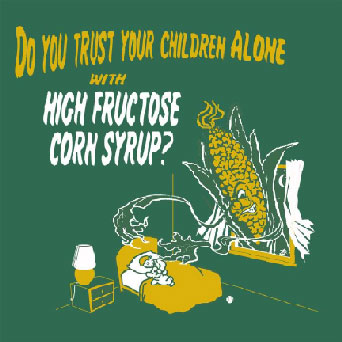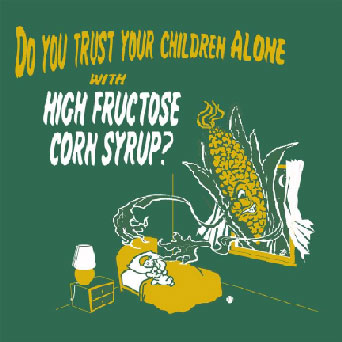 Sweet dreams: Look out! It’s Fructose Frutose Ghali! Graphic: T-Shirt InsurgencyOne of industry’s main arguments against critics’ targeting high-fructose corn syrup (HFCS) as Public Health Enemy No. 1 has been that HFCS and table sugar are chemically similar. Manufacturers have stated over and over that the most common form of HFCS in use in processed food is at most 55 percent fructose and 45 percent glucose — not significantly different from white sugar’s 50/50 fructose/glucose makeup. If you want to read up on the heated debate about whether this focus on the chemistry is misplaced, feel free.
Sweet dreams: Look out! It’s Fructose Frutose Ghali! Graphic: T-Shirt InsurgencyOne of industry’s main arguments against critics’ targeting high-fructose corn syrup (HFCS) as Public Health Enemy No. 1 has been that HFCS and table sugar are chemically similar. Manufacturers have stated over and over that the most common form of HFCS in use in processed food is at most 55 percent fructose and 45 percent glucose — not significantly different from white sugar’s 50/50 fructose/glucose makeup. If you want to read up on the heated debate about whether this focus on the chemistry is misplaced, feel free.
Now it turns out that the actual amount of fructose in HFCS in particular food products has never been officially disclosed, just assumed. And that assumption, much to the surprise of even the biggest HFCS-is-bad skeptics, has just been proven way off.
Researchers from the University of Southern California decided to test actual brand-name sodas — including Coke, Pepsi, and Sprite — to confirm their exact sugar content and makeup. They found that the HFCS in the vast majority contained far more than the presumed 55 percent fructose: in the case of those three brands, it was actually 65 percent fructose.
Why is this important? It’s because research has shown fructose to be particularly harmful to human health. Unlike excess glucose, which passes through our digestive tract and is excreted, 100 percent of fructose that’s consumed is taken up by the liver. Once there, fructose causes increased fat deposition in the abdominal cavity and increased blood levels of triglycerides — both of which are risk factors for heart disease and diabetes. So, over a lifetime, the HFCS in the 53 gallons of soda per year the average American drinks thus increases their fructose consumption compared to table sugar, and probably adds up to big health problems.
It’s easy to dismiss fears about HFCS when you can convince yourself that it’s just sugar under a different name (no, not that name). But now we’re learning that HFCS, as it’s used in soda — which for many Americans is the largest source of their HFCS consumption — is different, and in the worst possible way: it’s significantly higher in fructose.
Since this has been the food industry’s dirty little secret until now, we have no way of knowing how long soda drinkers have been enjoying their pop “Now With Extra Fructose!”
Perhaps it’s been a recent development, or perhaps HFCS producers have been making this higher fructose concoction for decades. Either way, this new study has gotten nutritionist Marion Nestle’s attention. And given that she was one of the most vocal critics of earlier work vilifying HFCS, perhaps now the media will start asking some hard questions about whether HFCS is in fact innocent of all charges, and it’s just the American sweet tooth to blame for all our ills. I can’t wait to hear how the Corn Refiners Association is going to respond to this one.
P.S. You hipsters who like to down a Mexican Coke with your burritos, thinking it’s made with table sugar (sucrose), not HFCS, might want to go back to the agua fresca. The USC investigators found no sucrose in the Coke, just glucose and fructose. Either Mexican Coke is being made with HFCS, or its manufacturers have for some reason split sucrose into its constituent glucose and fructose, Nestle says.



